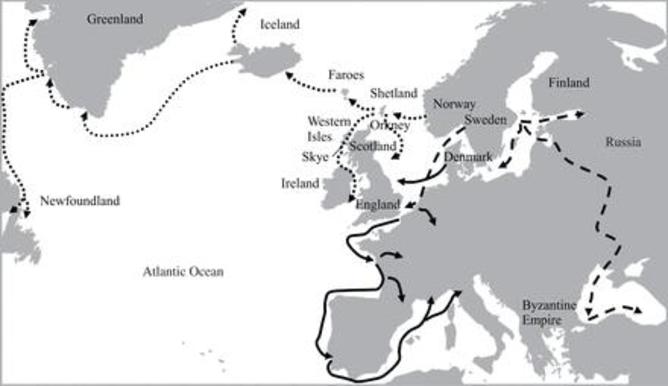Left out of this picture is their womenfolk, but with the results of state-of-the-art DNA sequencing techniques, geneticists from Norway and Sweden have provided a picture of the Viking world that reveals women travelled to settle in far-off places – and this appears to be true of born-and-bred Norsewomen as well as those from the lands visited.
Handed down the maternal line
The study, published by the Royal Society, sequenced DNA from 45 Norwegian, Viking-age skeletons. This was mitochondrial or mtDNA which, unlike most DNA, is passed down from mother to child with no input from the father. Children have near identical mtDNA to their mothers, their mother’s mothers, and so on. If you go back far enough, every person who has ever lived falls somewhere on a single, branching, maternal family-tree.
Within the tree, mutations lead to changes in the mtDNA sequence of one individual, which are then inherited by all of their female-line descendants. This means that by comparing differences across many individuals from known geographical locations, we can build up a picture of the movements of the women of the past. The mtDNA of the 45 skeletons was compared to many others which have been previously sequenced from around north-western Europe. Using a variety of statistical tests, several things became apparent.
Many of the mtDNA sequences were shared between those from Norway and those of the lands the Vikings colonised. This supports archaeological and historical sources which suggest that the Norsemen often married at home and were accompanied on their voyages by their wives. However, the picture is not uniform from place to place.
Relatively close to Scandinavia, in Orkney and Shetland, modern populations show similar levels of ancestry coming from Norse-folk of each sex. Further away in Iceland, people owe more of their ancestry to Norsemen than to Norsewomen. This poses the question, who were the remaining Viking wives? It seems unlikely that they were pre-existing Icelanders, as Iceland was largely uninhabited before the arrival of the Vikings. Although there is some evidence for habitation, it was on a small scale, and maybe by then extinct. The Viking Sagas mention the presence of monks, but even if they were real, they would be male and also – one imagines – celibate.

The Vikings had legendarily itchy feet. Krzewińska et al., 2014
Where are the Viking women at?
One test showed that if the genetic contribution of Norwegians is subtracted from Icelandic mtDNA data, what remains is most similar to Orkney and the Western Isles of Scotland. So it seems likely that Gaelic women from these islands arrived in Iceland with the Vikings, or else had been integrated into these colonial Viking communities in previous generations and passed down their mtDNA to those that made the voyage to Iceland.
Either way, it shows that many more women than men from invaded lands were assimilated into Viking colonies. Maybe this shouldn’t surprise us – around the world, it’s much more common for women than men to join the family or tribe of their spouse when married. The Vikings also enslaved prisoners from defeated peoples, and wherever men own slaves, they will father children by them. Again its not surprising that female slaves would leave more of a genetic legacy than their male counterparts.
The study also suggests this dynamic may have been the norm back in Norway too. Two of the 45 samples (both from female skeletons buried in the Norse fashion) appear to have mtDNA not typical of the Vikings. One had a sequence previously seen among Scandinavia’s northernmost people, the Saami (or Lapps) – probably a Saami woman who married a Viking, or the female-line descendant of one.
The other skeleton had mtDNA from a branch of the family tree common across Asia. There are many possibilities, but again it is likely this woman (or her maternal-line ancestor) was brought back by Vikings from a voyage to Russia or the Byzantine Empire.
New tools, new knowledge
With ever-improving tools for geneticists, we can now look further into the genetic subtleties of the past. This study used skeletons excavated in the days before DNA sequencing was an option. Until recently, such specimens have been un-sequenceable due to DNA contamination from the modern people who have handled them. Today’s techniques make it possible to differentiate modern from ancient DNA sequences, which opens up the prospect of returning to the many museum specimens in collections worldwide to see what further answers they might hold of the Vikings' many adventures.
This post originally appeared ion The Conversation.










